NIL
Will the Oklahoma Sooners be active in the transfer portal after WCWS?
AI-assisted summary Oklahoma Sooners softball is expected to return a strong lineup in 2026, retaining 90.4% of home runs and 91.9% of RBIs. The Sooners’ pitching rotation is less certain, with returning pitchers accounting for only 54% of 2025 wins. Head Coach Patty Gasso is likely to utilize the transfer portal to bolster the pitching […]
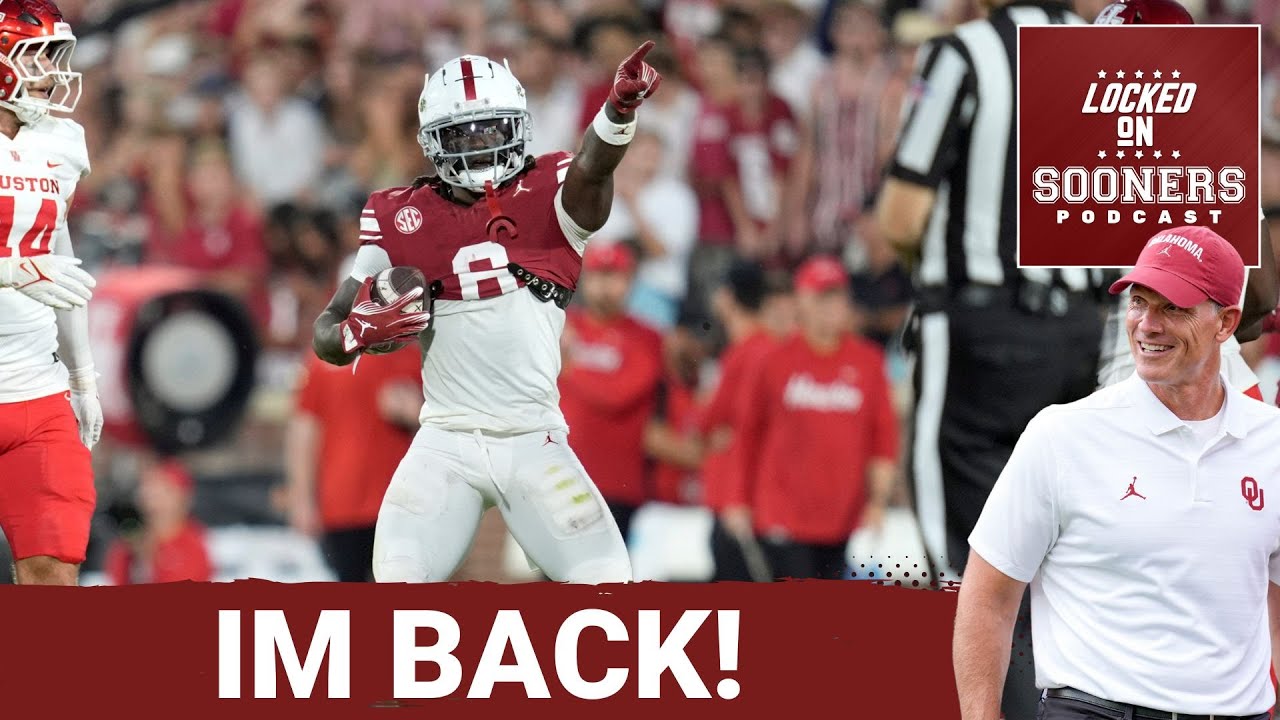


- Oklahoma Sooners softball is expected to return a strong lineup in 2026, retaining 90.4% of home runs and 91.9% of RBIs.
- The Sooners’ pitching rotation is less certain, with returning pitchers accounting for only 54% of 2025 wins.
- Head Coach Patty Gasso is likely to utilize the transfer portal to bolster the pitching staff, as she has in previous seasons.
The NCAA softball transfer portal schedule is as whacky as it is in football and basketball, where the portal is open and active before the season reaches its conclusion. There are already players entering the portal and finding new homes while the final eight teams prepare for the Women’s College World Series.
As the Oklahoma Sooners pursue their fifth straight national championship, the team is predominantly focused on what happens over the next week and a half in Oklahoma City. However, a coaching staff like the Oklahoma Sooners, who are forward-thinking, will have an idea of what their needs may be after this season.
The Sooners are a young team. The only players to walk on senior day were Cydney Sanders, Sam Landry, and Isabella Smith. OU has 19 players slated to return in 2026. 13 of them are freshmen or sophomores. Here’s what their lineup could look like on opening day in 2026.
- Kasidi Pickering, LF
- Ella Parker, UT
- Gabbie Garcia, SS
- Nelly McEnroe-Marinas, 3B
- Sydney Barker, 1B
- Ailana Agbayani, 2B
- Hannah Coor, CF
- Isabela Emerling, C
- Abigale Dayton, RF
The Sooners are slated to bring back 90.4% of their home runs and 91.9% of their RBIs from 2025.
Sanders is the only regular from the lineup the Sooners are slated to lose at this point. Players like Tia Miloy, Maya Bland, and Chaney Helton will be factors in the outfield. Corri Hicks, Riley Zache, and Kadey Lee McKay will get innings in the infield and at catcher. The Sooners will return the corps of their roster that helped them win the SEC in 2025.
It’s a group that will only continue to get better.
Could there be a surprise or two? Absolutely. It’s the transfer portal era. But that’s a lineup that will contend once again in 2026.
Where Oklahoma may have a transfer portal need is in the circle. Landry has been a star for the Oklahoma Sooners this season, racking up a 23-4 record heading into the WCWS. Smith has been an important second option as a starter. The Sooners have Kierston Deal, Audrey Lowry, Peytn Monticelli, and Sophia Bordi, who could all return for 2026. That group returns just 54% of the Sooners’ wins from this season.
It’s a good group that Patty Gasso and Jennifer Rocha have to work with. Deal and Monticelli provide veteran options for the Sooners, while Lowry and Bordi have frontline starter upside. Despite the upside, the Sooners have added a veteran in the portal several times in recent offseasons. Over the last few years, the Sooners added veteran arms like Hope Trautwein, Alex Storako, Kelly Maxwell, Landry, and Smith.
The Oklahoma Sooners have shown a willingness to go into the portal to add a significant piece to their lineup or in the circle over the years. Though they’ll bring in one of the best recruiting classes in the country in 2026, Gasso will also keep the Sooners active in the portal.
Contact/Follow us @SoonersWire on X, and like our page on Facebook to follow ongoing coverage of Oklahoma news, notes, and opinions. You can also follow John on X@john9williams.
NIL
NIL Money Sways Some Potential NBA Draft Picks To Stay In School
NBA or NIL? Yaxel Landeborg’s decision to remain in college is a recent trend. (Photo by Michael … More Wade/Icon Sportswire via Getty Images) Icon Sportswire via Getty Images The 2025 NBA Draft does not look much different at the very top this year than in other years, where the projected stars reside. Cooper Flagg […]
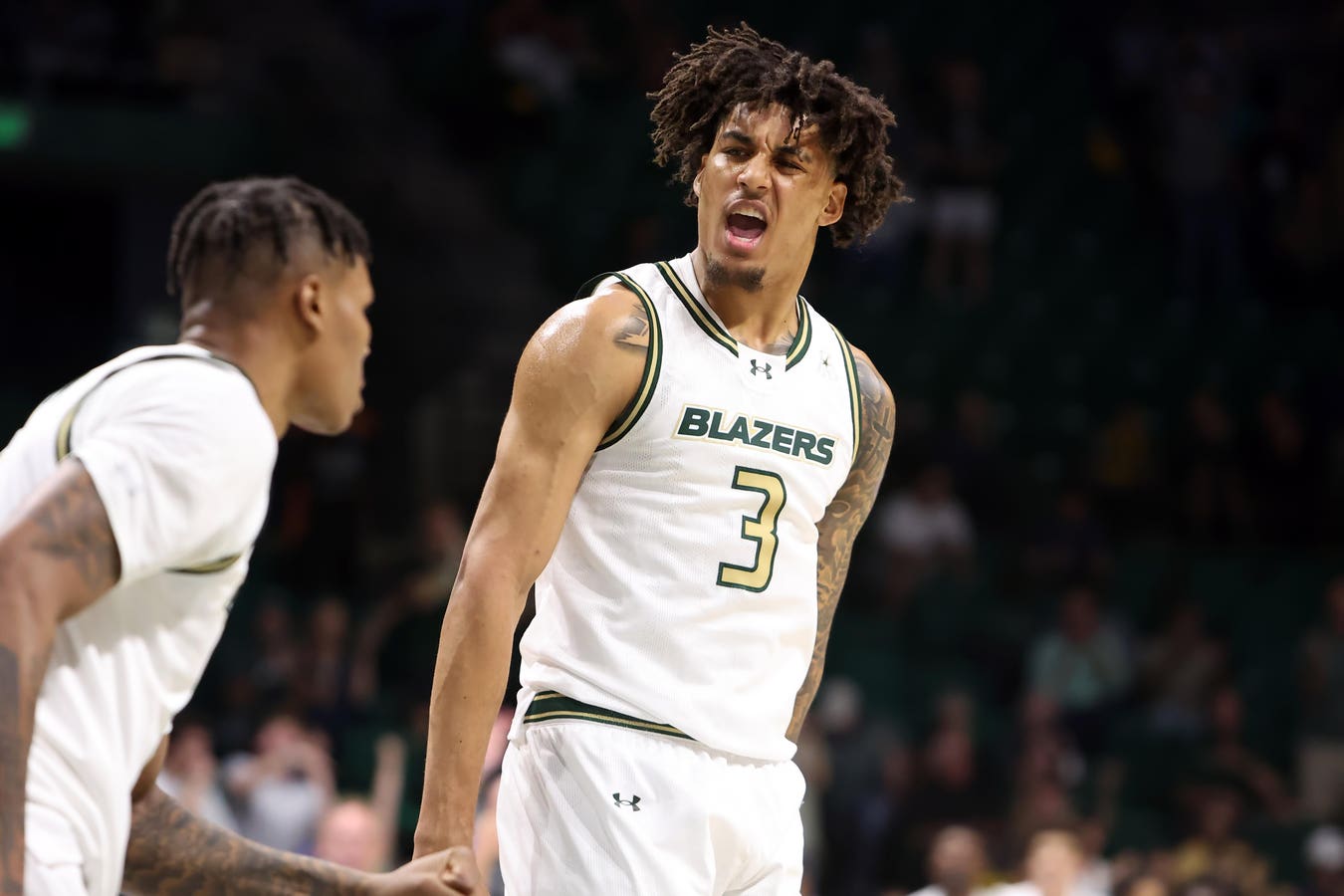
NBA or NIL? Yaxel Landeborg’s decision to remain in college is a recent trend. (Photo by Michael … More
Icon Sportswire via Getty Images
The 2025 NBA Draft does not look much different at the very top this year than in other years, where the projected stars reside. Cooper Flagg and Dylan Harper sit there now.
The overall pool for the June 25-26 draft, however, is considered to be one of the weakest in recent years, with the decline most evident in the lower third of the first round, picks No. 21-30.
Blame/credit NIL.
The benefits available to top college athletes through their name, image and likeness earnings — plus another year of a college scholarship — appear to be major factors in motivating some potential lower level first-rounders to stay on campus.
Florida’s Alex Condon (21) returned for a second shot at the Final Four (AP Photo/Eric Gay)
Copyright 2025 The Associated Press. All rights reserved
Florida forward Alex Condon, Florida transfer guard Boogie Fland, Michigan transfer forward Yaxel Lendeborg, Auburn guard Tahaad Pettiford and Houston forward Milos Uzan are among those who pulled their name from the list of early draft entrants just before the June 15 deadline.
Stay In College, Still Get Paid
“Now these kids can go to college and get paid,” an unnamed NBA agent told ESPN while discussing the 2025 draft, “and most of these kids would prefer to go to college and play in March Madness and do these things, if all things are equal.”
Add the NIL money to the factors that a player who declares for the draft while retaining the college eligibility must consider.
The NBA can provide players generalized feedback on where they might fall in the draft. Late in the first round. Early second round. Etc. Before, those evaluations may not matter to a motivated player.
After leaving Arkansas, Boogie Fland abandoned the NBA draft and agreed to a $2.1 million NIL deal … More
Copyright 2024 The Associated Press. All rights reserved.
Now, the NIL money adds another element.
Lendeborg is a prime example. After playing two seasons at Arizona Western junior college and two more at UAB, he entered the transfer portal in March and chose to attend Michigan while at the same time keeping his name in the draft pool.
Considered considered a potential late-first rounder or early second-rounder, Lendeborg pulled his name and has an NIL deal with the Wolverines worth $2.3 million, according on On3, which monitors NIL forces.
Fland, a transfer from Arkansas, has a $2.1 million NIL deal in place with defending national champion Florida, according to On3.
Condon had 12 points and secured the game-winning rebound in the Gators’ 65-63 NCAA championship victory over Houston. His NIL deal with the collective Florida Victorious was not announced.
The Money Has Evened Things Out
“One of the huge benefits of the NIL world, you don’t have to sacrifice for maybe as tough of a fiscal decision between going pro or staying now,” Florida coach Todd Golden said at the SEC spring meetings.
“Fortunately, he’s positioned himself nicely that way.”
The money has evened things out.
NBA rookies sign four-year contracts that are determined on a sliding scale by when they were taken in the draft, and the figures are out for the 2025 draft class. Most contracts are guaranteed.
The stated value of the No. 1 pick — Flagg — is $62,730,226 for his first four seasons, according to Sportico, with a starting salary of $13.8 million in 2025-26. There also is some wiggle room as players can sign for as low as 80 percent of a high as 120 percent of their allotted figure.
By the late first round, however, the college and NBA money is relatively the same. The No. 25 pick in the 2025 draft is scheduled to earn $2.99 million in his rookie year. The No. 30 pick is to earn $2.74 million.
Moreover, contracts for players taken in the second round are not automatically guaranteed and are not governed by the rookie scale. Sacramento’s Colby Jones signed the largest contact among second-rounders last season, at $8.8 million for four years.
Lendeborg and Fland are being paid in the same range to stay in college, which also has its benefits.
They and others like them will get another shot at an NCAA title, and they also have a chance to increase their standing in the next draft (or several) depending on their 2025-26 performance. Uzan played in the NCAA title game a year ago, Auburn was No. 1 most of the season and Michigan made the Sweet Sixteen.
For a player not in the lottery or close to it, a decision to stay can look like a win-win.
NIL
Wisconsin sues Miami, alleging tampering in football player's NIL deal
MADISON (WKOW) — UW-Madison is taking legal action after a football player with star potential left the Badgers to play at the University of Miami over the winter. The case could have major implications for how the NCAA handles NIL deals and player transfers. UW-Madison and VC Connect LLC have filed a lawsuit against the University […]


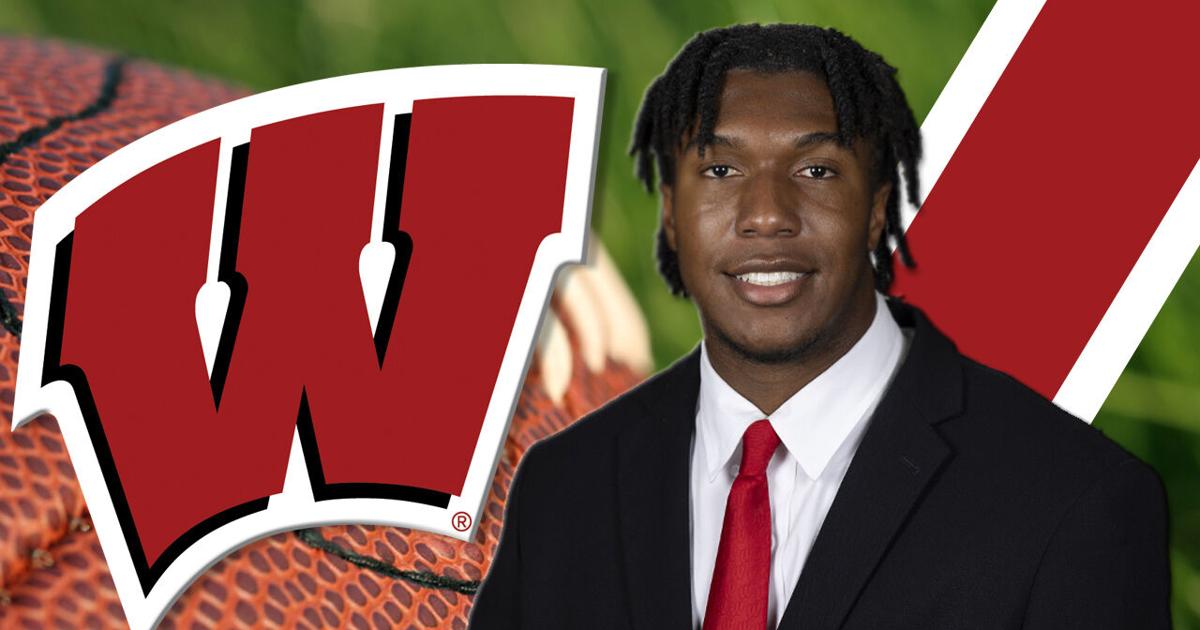
MADISON (WKOW) — UW-Madison is taking legal action after a football player with star potential left the Badgers to play at the University of Miami over the winter. The case could have major implications for how the NCAA handles NIL deals and player transfers.
UW-Madison and VC Connect LLC have filed a lawsuit against the University of Miami, alleging the Hurricanes wrongfully interfered with Name, Image, and Likeness (NIL) contracts. The complaint, filed on Friday, claims Miami induced Xavier Lucas to break his agreements and transfer.
Lucas had signed lucrative NIL contracts with UW-Madison and VC Connect for the 2025 season. However, Miami allegedly tampered with these agreements, causing him to leave Madison and enroll at Miami, violating NCAA anti-tampering rules.
The up and coming cornerback entered the transfer portal in December 2024. He was coming off a freshman season where he played 11 games, recording 18 tackles and grabbing an interception.
Lucas was a four-star prospect coming out of high school. He was born in Pompano Beach, Florida, about an hour north of Miami.
The complaint outlines how Miami’s actions resulted in significant financial and reputational harm to the plaintiffs. It also highlights the broader implications for college athletics, emphasizing the need to protect contractual commitments amid the evolving NIL landscape.
Miami’s conduct reportedly included contacting Lucas and offering more lucrative financial terms, despite the player’s existing commitments. UW-Madison and VC Connect seek damages and a declaration that Miami’s actions constituted tampering.
The University of Miami has not yet responded to the allegations.
NIL
Wisconsin Sues Miami over NIL Deal
In January, a Wisconsin player (Xavier Lucas) signed in NIL deal and then left to go to Miami – outside of the transfer portal. Wisconsin is alleging that Miami interfered with a binding contract. No idea if this will be successful. But, it calls the question on whether NIL deals are enforceable against players. If […]

In January, a Wisconsin player (Xavier Lucas) signed in NIL deal and then left to go to Miami – outside of the transfer portal. Wisconsin is alleging that Miami interfered with a binding contract.
No idea if this will be successful. But, it calls the question on whether NIL deals are enforceable against players. If they aren’t, then it is hard to imagine what rights schools actually have. Players can theoretically just leave any time they feel like it if someone else offers more money.
https://www.espn.com/college-football/story/_/id/45552578/wisconsin-sues…
NIL
What’s new with the Arizona Men’s Basketball 2025-26 roster
TUCSON, Ariz. — During the off season, Arizona Men’s Basketball got busy. Head Coach Tommy Lloyd and his staff landing the fourth best recruiting class in the country, all while entering a new era of college athletics. “It’s college basketball,” Lloyd said. “There’s a lot of moving parts in an off season now. You talk […]
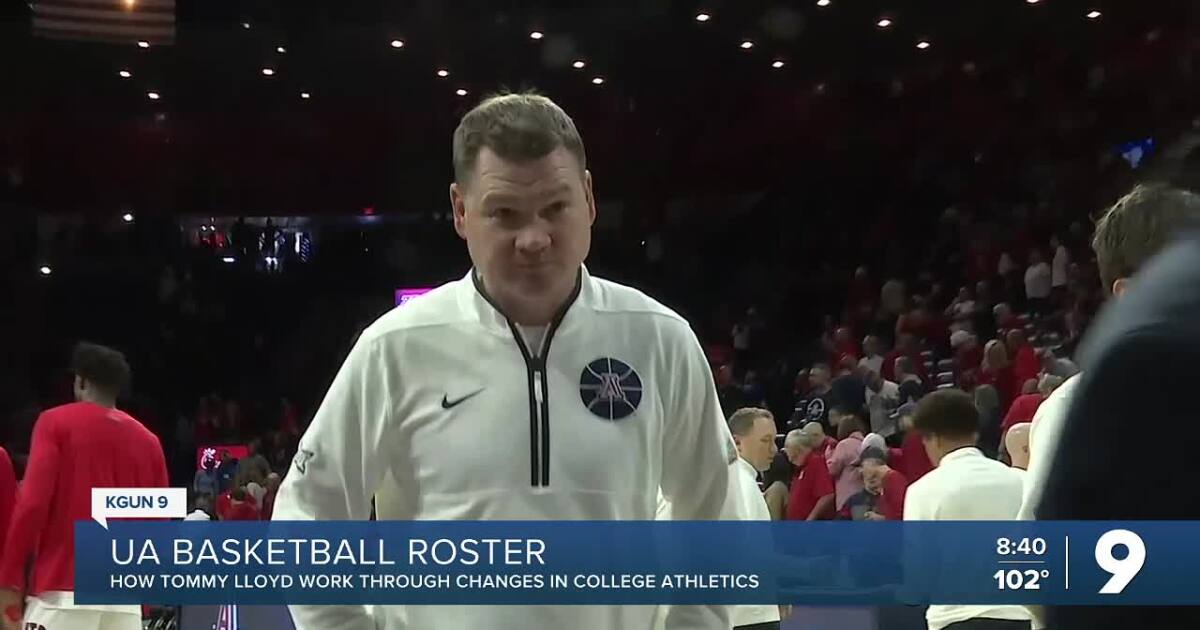
TUCSON, Ariz. — During the off season, Arizona Men’s Basketball got busy. Head Coach Tommy Lloyd and his staff landing the fourth best recruiting class in the country, all while entering a new era of college athletics.
“It’s college basketball,” Lloyd said. “There’s a lot of moving parts in an off season now. You talk about transfer portal, NIL, the house settlement but you work yourself through it and you’re trying to do the best job to set your next team up for success.”
While the Wildcats will have multiple returning players, the program will be seeing many new, and young, faces for the 2025–2026 season.
“At some point you got to recruit some younger players and the one thing we did know going into this season was that this was going to be the fifth season post COVID,” Lloyd said. “We knew those kids that were granted that automatic waiver for the extra year of eligibility, that was going to dry up.”
Along with four returning players, Jaden Bradley, Anthony Dell’Orso, Tobe Awaka and Motiejus Krivas, the Wildcats bring in seven new players, six of them being freshman.
Joining Arizona are three 5-Star recruits, Dwayne Aristode, Brayden Burries and Koa Peat. Two international players, Mabil Mawut and Sidi Gueye. A transfer from Harvard, Evan Nelson, and rounding out the additions, 3-Star recruit, Bryce James.
Even in the changing landscape of college athletics while recruiting Lebron James’s son, Lloyd had no hesitations when it came to Bryce.
“Sometimes I think it’s unfair to a kid like Bryce,” Lloyd said. “Their are people kind of making decisions on his future. Not his family’s future, Bryce’s future, just based on who his parents are. He’s a 17-year-old kid, he’s just moved away from home and he’s running his own race. Let’s give him some space and let him develop into his own man.”
Lloyd and his staff building this roster in the heat of NIL and the NCAA house settlement that will now allow schools to pay it’s players directly.
“I’m a coach,” Lloyd said. “I’m somebody who, you let me know what the rules are, and I’m going to figure out how to work with the rules to make our program successful.”
Arizona Athletics announced its five-year plan, the Bear Down Blueprint, hoping to give direction when the house settlement is implemented.
“That’s all I care about,” Lloyd said. “My team is judged on our performance and so I have to focus on how to make our team perform better. We have a staff that’s a lot smarter than me within this athletic department at figuring that stuff out and I’m just going to follow their lead.”
——
Erin Patterson is a reporter for KGUN 9. She’s agraduate of the University of Alabama with a Bachelor’s in News Media with a Sports Concentration. Erin recently obtained her Master’s Degree in Sports Journalism from Arizona State University at the Walter Cronkite School of Journalism, where she gained experience a sports reporter, anchor and producer. Share your story ideas and important issues with Erin by emailing erin.patterson@kgun9.com.

—-
STAY IN TOUCH WITH US ANYTIME, ANYWHERE
NIL
Cache AI enters NIL arena at Section 7 to evaluate athlete potential
Vail’s Cienega High School defeats Tempe’s McClintock to earn one of six qualifying spots for the Section 7 boys basketball tournament at Arizona Athletic Grounds on June 18, 2025. (Photo by Payne Moses/Cronkite News) Cache AI, an evaluator tool driven by artificial intelligence, gives players a 0-100 rating based on what they offer as an […]
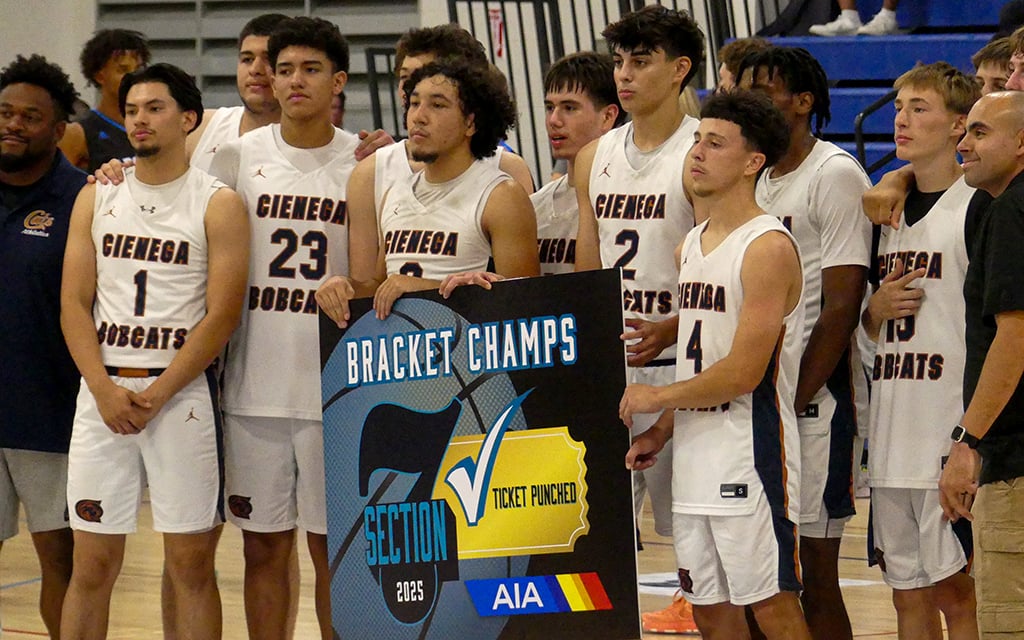

Vail’s Cienega High School defeats Tempe’s McClintock to earn one of six qualifying spots for the Section 7 boys basketball tournament at Arizona Athletic Grounds on June 18, 2025. (Photo by Payne Moses/Cronkite News)

Cache AI, an evaluator tool driven by artificial intelligence, gives players a 0-100 rating based on what they offer as an athlete and person. (Photo by Payne Moses/Cronkite News)

Players on Tucson’s Sahuaro High School’s basketball team watch from the bench against Phoenix’s Arcadia in a Section 7 tournament qualifying game at Arizona Athletic Grounds in Mesa on June 18, 2025. (Photo by Payne Moses/Cronkite News)

Arizona high schools from across the state competed for six spots in the Section 7 boys basketball tournament on 16 different courts at Mesa’s Arizona Athletic Grounds on June 18, 2025. (Photo by Payne Moses/Cronkite News)

Mesa’s Arizona Athletic Grounds is host of the Section 7 high school basketball tournament for the first time this year. (Photo by Payne Moses/Cronkite News)
MESA – Each coach and team has their needs, but in today’s athletic climate of NIL and revenue sharing, it’s hard to tell an athlete’s value.
One startup online platform is hoping to make that confusion a thing of the past.
Cache AI, an athlete evaluation tool powered by artificial intelligence, was launched on June 6 and its first athletes in the system are participants of the Section 7 high school basketball tournament in Mesa. In April, Section 7 announced Cache AI as its presenting partner for 2025.
“Not only can we help (coaches’) players understand their brand as part of their development … we can help with both NIL value and revenue value,” said Kobi Wu, founder and CEO of Cache AI.
Cache AI is designed to help coaches to identify talent in an unbiased way, with nothing to gain and nothing hidden under the table.
All boys and girls were given a CacheScore, which is a 0-100 rating that is optimized by the tool’s AI-infused algorithm and an accompanying athlete profile with their GPA, social media presence, sport skills and more such as community service efforts. Every player entered with a “pre-generated” profile which they can then improve with their personal input, according to Wu.
The 2025 edition of Section 7 – first introduced in 2019 by Matt King, University of Arizona’s president of basketball operations – moved to Mesa following three years at Glendale’s State Farm Stadium.
If 12 simultaneous basketball games wasn’t enough, Arizona Athletic Grounds allows for 16. With 96 Arizona teams battling for tournament entry over just two days, the chaos may be overwhelming for first-timers but it has license to unfold.
What does 8 high school basketball games look like all at once? And sound like?
Here you go.@Section7Az @sportscronkite pic.twitter.com/AEYCcDWSm8
— Payne Moses (@pwmoses11) June 18, 2025
As Section 7 benefits the host venue, hosting partners and the statewide economy, its slogan is undeniably player-first: “Where talent meets opportunity.”
The massive showcase is making efforts to expand its pull even further with the event’s founder, Arizona Basketball Coaches Association, partnering with the Arizona Sports & Entertainment Commission.
Wu said she met up with ASEC executive director Nikki Balich in February to discuss the mutual partnership after Balich expressed her belief in the service over the phone.
“(Balich said) ‘I want to do something great for the kids in the tournament,’” Wu said. “And I said, ‘That’s why we’re here.’ That’s why we exist. … We’re athlete-first. We want the kids to have an understanding of their value always. Things shouldn’t just be put upon them.”
Without the burden of curating their overall value, athletes like Jackson Moore of Vail’s Cienega High School can focus on their play.
In the midst of officials blowing whistles left and right, hundreds of fans roaming about and cheering and basketballs taking liftoff on Wednesday, Moore and Cienega punched one of six tickets into the weekend’s Section 7 tournament at Arizona Athletic Grounds.
“To qualify is amazing because we get to play in front of all (these) college coaches, scouts, everything,” Moore, a rising junior, said. “We’ve been in this environment before. We were able to qualify last year, made it, won a game (after) qualifying last year, so it was an amazing experience.”
.@AZPreps365 Cienega beat McClintock to punch their ticket to the @Section7Az weekend tournament.
The Bobcats also advanced in the 2024 edition but had to win an extra game (4) this time around with a larger field.@sportscronkite pic.twitter.com/tpAVesEcKy
— Payne Moses (@pwmoses11) June 18, 2025
For Nick Springer, a rising senior at Scottsdale’s Chaparral High School, college basketball is a goal of his. And he has the chance to increase his exposure to college-level coaches this weekend with his team defeating 5A rival Desert Mountain to qualify for the tournament. El Mirage’s Dysart, Tucson’s Salpointe, Phoenix’s Arcadia and Peoria’s Centennial rounded out the Arizona qualifiers.
“I’ll see how the year goes, but (college) is definitely an option,” Springer said.
This year, coaches from 261 universities, including Arizona State, Arizona, Grand Canyon and Northern Arizona, will be in attendance, according to Balich. They already witnessed about 2,200 girls play and, once this weekend concludes, about 3,840 boys.
Just because the NCAA sanctions this event, that doesn’t prevent NAIA coaches, especially local ones, from coming out.
Tyler Ojanen, Ottawa University Arizona men’s basketball coach in Surprise, said he will be present for all five competition days. Though he’s “taking it all in,” Ojanen said he is looking to add a point guard for this upcoming season.
Ben Olesen, a second-year assistant for Embry-Riddle Aeronautical University in Prescott, said his team is on the lookout for “bigs” as most of their seven freshmen last season were guard-type players.
In the early years of NIL activation, college programs have witnessed athletes receive money, but money of arbitrary value. As the House v. NCAA case reached an initial settlement on the same day Cache AI launched in Mesa, Wu said she wants to be in on the conversation to aid schools with understanding where NIL funds are streaming from.
Wu added she thought Cache AI’s start would be directed at college athletic directors – with the tool being in direct communication with colleges – and “a few elite high school programs,” but Section 7 came knocking.
Balich said she had conversations about the new tool at a Power Four school three weeks back and the school had a false perception of the service.
“‘(Cache AI) is all biased, right?’ Balich said the school asked her. “Cache AI doesn’t represent any student. They will never represent any athletes. … Cache doesn’t care who picks the students up. They’re just offering the thing. … You know, Kenny (Dillingham) you make the decision.”
The tool has the potential to be a game-changer, according to Balich.
“I know that if people take a look at it and stop thinking that they know everything about AI, and what this could be, dude, this thing’s bomb. This is Nike before Nike,” Balich said.
Besides a free CacheScore, Section 7 participants will have access to the whole tool until a few days after the tournament and the option to continue using it, according to Wu. The key: players aren’t the ones that pay, but rather the schools.
“Players should be able to know how their brand is pacing and they should be able to have control or some transparency in that,” Wu said.
Every player competing in @Section7Az has plenty of food and beverage options at Arizona Athletic Grounds.
And there’s a flaming basketball encouraging fans to check out official event merchandise.@sportscronkite #WhereOpportunityMeetsTalent pic.twitter.com/S70CFdS1on
— Payne Moses (@pwmoses11) June 18, 2025
Beginning Friday, 166 high school teams from the following states will compete for sectional glory: Arizona, California, Utah, Colorado, New Mexico, Nevada, Idaho, Oregon, Washington, Hawaii and Florida.
Teams will win and teams will lose. Individuals will prove their skill and individuals will perhaps have eyeballs on their craft for the first time.
But with the unique opportunity to develop athletic branding, coaches and players may leave Mesa empowered beyond a significant yet fleeting tournament.
Cesar Chavez boys basketball coach Marcus Wright, who played collegiate basketball at Point Park University in Pittsburgh, Pennsylvania, said some of his players are considering the next level but need to “match the work ethic and energy level” required.
This scholastic showcase and new tool are designed to spark those aspirations and, more importantly, shine light on life skills.
“Three pillars we are focusing on beyond the CacheScore and CacheValue is financial literacy, community service leadership and the third is brand and career development,” Wu said.
“(Players) are going to get recruited. Yes, that is the focus,” Wu said. “But it’s also for development.”
NIL
Colorado Buffaloes legend Shedeur Sanders addresses off-field mistakes during Browns charity softball game
It’s not exactly the spotlight Shedeur Sanders had in mind. Just days after being cited for driving 101 mph in a 60 zone—which is apparently his second speeding ticket in less than two weeks—former Colorado Buffaloes quarterback Shedeur Sanders finally broke his silence. But it didn’t come in a press conference or through a team-issued […]
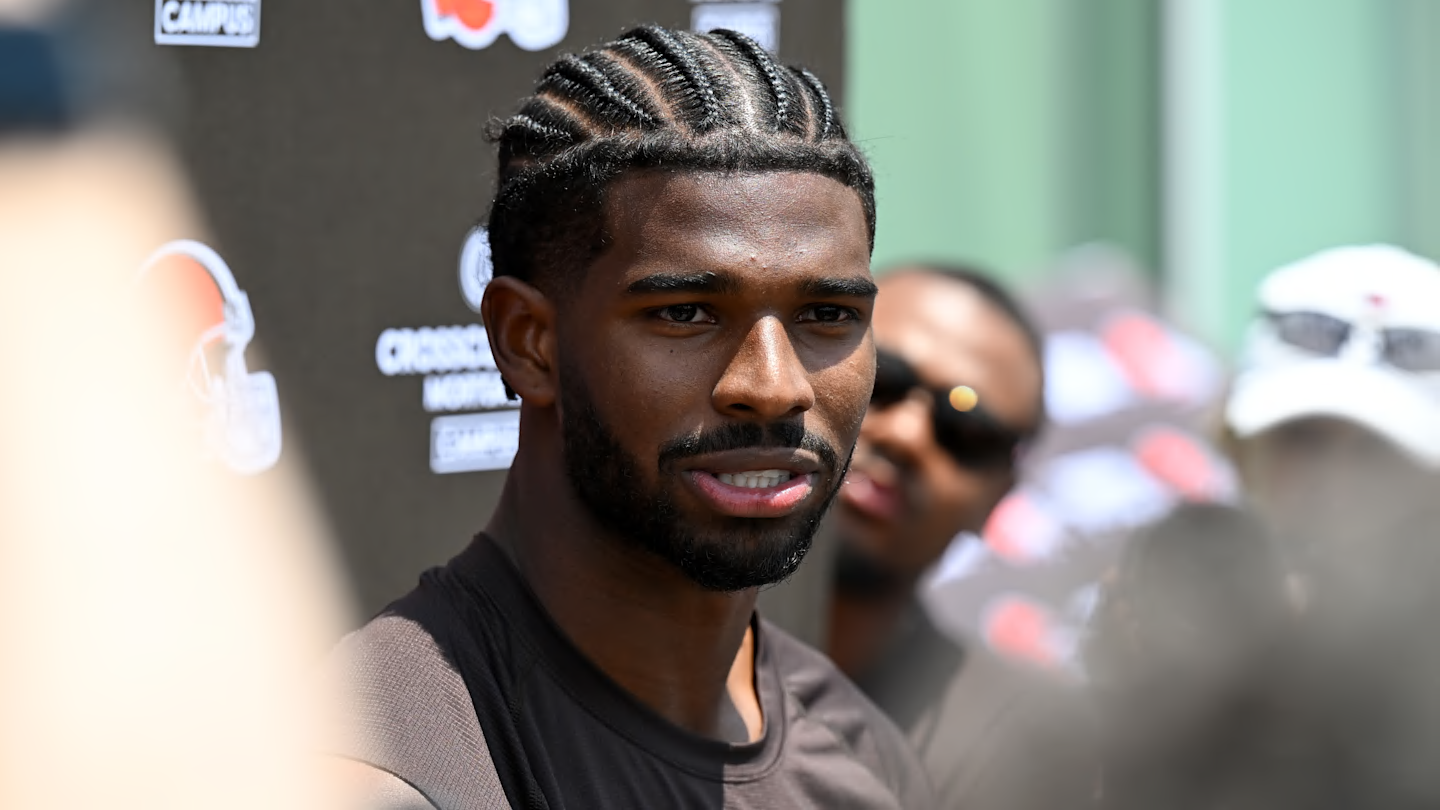
It’s not exactly the spotlight Shedeur Sanders had in mind.
Just days after being cited for driving 101 mph in a 60 zone—which is apparently his second speeding ticket in less than two weeks—former Colorado Buffaloes quarterback Shedeur Sanders finally broke his silence.
But it didn’t come in a press conference or through a team-issued statement. It came in a softball dugout.
At David Njoku’s Celebrity Softball Game in Eastlake, Ohio, Sanders turned a lighthearted exchange with rapper Doe Boy into something deeper.
“I’ve made some wrong choices,” Sanders said, smiling, but not ducking. “I can own up to it. I learn from them.”
Shedeur Sanders said this about his speeding violation:
“I’ve made some wrong choices, I can own up to it—I learn from them”
pic.twitter.com/RUTa1IJ20f
— GUCCE
(@gucceCU) June 19, 2025
It was a shift in tone—something that felt needed after a rough couple of weeks for Sanders’ image.
Because let’s not sugarcoat it: this isn’t a good look.
Sanders is in the middle of a three-way quarterback competition in Cleveland. He’s a fifth-round pick trying to earn a spot in a room that already includes Joe Flacco, Kenny Pickett, and fellow rookie Dillon Gabriel.
Every rep matters. Every impression matters.
And now, instead of the media focusing on whether Shedeur’s talent will translate to Sundays, the conversation has veered off the road entirely—literally.
More details have been coming out due to court records becoming public. He’s had, not one, but two speeding tickets, and even worse, he missed a court date for one of them. His first ticket, 91 mph in a 65, came on the final day of Browns OTAs. The second, 101 in a 60, happened during rookie orientation.
That kind of pattern raises questions, not just about maturity, but about commitment—fair or not.
As someone who just this week defended Sanders against early OTA overreactions, this is frustrating.
I wrote that we shouldn’t read too much into June minicamp reps. That it was far too early to crown Dillon Gabriel or count out Shedeur Sanders.
But you can’t afford two high-speed citations and off-the-field distractions when you’re still earning a spot.
To Shedeur’s credit, he seems to understand that. And you could see it on his face during the softball game. The smile was there, sure. But so is the weight. This was a young quarterback trying to own it and move forward.
And to be fair, it wasn’t all bad news in Ohio.
Sanders was swarmed by fans, including one young voice yelling, “You’re QB1! Nobody else but you!” Sanders smiled and replied, “I need him to be my motivator.” He laughed, signed autographs, and even knocked in an RBI double—showing off a bit of the two-sport DNA he inherited from his Hall of Fame father.
Shedeur Sanders looking like Pop’s

#NFL #dawgpound #SkoBuffs
pic.twitter.com/SbHr4nA4Rr— Ossacin’s Ducktail (@OssacinDucktail) June 20, 2025
This is still the same Shedeur Buffs fans remember. The young man who made Colorado football matter again.
But if he wants to win over Cleveland—and win this quarterback battle—he has to prove more than just talent. He has to prove he can be trusted.
Right now, the Browns are saying very little publicly. According to reports, they expect Sanders to “take care of” the tickets. But there’s no doubt the coaching staff is watching closely.
They have to. In the NFL, your off-field decisions matter just as much as your arm strength, availability and accountability.
There’s still time for Shedeur to right the ship. Rookies report to training camp on July 18. Between now and then, Sanders has to show growth—off the field, in the playbook, and in his daily discipline.
One quote won’t erase his two speeding tickets. But maybe, just maybe, it’s the start of a better chapter.
— Want more stories like this? Follow us on X for all things Colorado Football and Basketball.
-

 High School Sports2 weeks ago
High School Sports2 weeks agoParents Speak Out As Trans Pitcher Throws Shutout In MN State Quarterfinals
-

 Professional Sports2 weeks ago
Professional Sports2 weeks ago'I asked Anderson privately'… UFC legend retells secret sparring session between Jon Jones …
-

 Health2 weeks ago
Health2 weeks agoOregon track star wages legal battle against trans athlete policy after medal ceremony protest
-

 Professional Sports2 weeks ago
Professional Sports2 weeks agoUFC 316 star storms out of Media Day when asked about bitter feud with Rampage Jackson
-

 NIL3 weeks ago
NIL3 weeks agoNCAA Sends Clear Message About Athlete Pay and Roster Limits
-

 NIL3 weeks ago
NIL3 weeks agoMen's college basketball Top 25 reset
-

 Social Media3 weeks ago
Social Media3 weeks agoControversial Athletics Gender Dispute Goes Viral After Riley Gaines Lashes Over Authorities
-

 College Sports2 weeks ago
College Sports2 weeks agoOKC’s Mark Daigneault knows what it takes to win championships. His wife has won a ton of them
-

 Rec Sports3 weeks ago
Rec Sports3 weeks ago2x NBA All-Star Reacts to Viral LeBron James Statement
-

 Motorsports1 week ago
Motorsports1 week agoNASCAR Weekend Preview: Autódromo Hermanos Rodríguez


















 | WNBA on ESPN
| WNBA on ESPN














